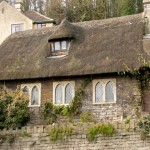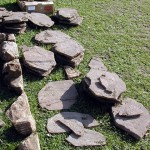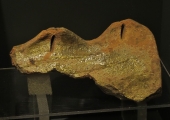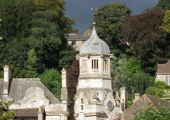.
Roofing
Bradford on Avon, Wiltshire
.
Local stone tiles on the Tithe Barn, Barton Farm, Bradford on Avon
.
The town of Bradford on Avon and its neighbouring villages demonstrate a wide variety of roofing materials. The earliest was probably thatch, but delicate organic material from ancient times rarely survives except a impressions in plaster. It is made of layers of vegetation, such as reed or straw, sloping downwards fairly steeply so rain drips from the ends of each strand. Thatch looks good, is the best insulation, but there is a fire risk.
Stone tiles appear in the building of Roman villas, such as those at Budbury in Bradford and near Atworth. For roofing the local buildings the stone was imported Pennant Sandstone, which would have been brought from the area around where Bristol now stands. Some parts of the sequence of Pennant beds, from Coal Measures strata laid down in the Carboniferous Period, can be split into slabs that are flat, but thick and heavy and would have been costly to transport and required strong timber support. Roman roof tiles were usually trimmed into a long hexagonal shape, fastened by a nail or peg at the top and laid in overlapping rows.
In relatively more recent times stone for roofing was dug from certain beds of the local Middle Jurassic Forest Marble Series. These are shelly limestone or sandstone that split into thin plates and are much lighter that the Pennant Stone the Romans used. They can be seen in large quantities on many of the older buildings in and around Bradford.
Slate roofing did not become common until the development of the railways to bring it from North Wales in the 19th century, although coarser Cornish and Devon slates were brought earlier by ship to Bristol. Welsh Slate is thin, light and fits more closely than the local tilestones, so could be used on lighter roofs with a less steep pitch.
Ceramic terracotta roof tiles may have been used in the Middle Ages, in combination with glazed V-section tiles along the ridge of the roof. Much of the ceramic tiles on older roofs in Bradford are of the 19th century and later, usually imported by rail from works at Bridgwater in Somerset. Known as ‘Romans’ from a resemblance to Roman terracotta tiles, they were designed to lock together and have projections that hook over roof battens without the need for nails. Modern tiled roofs are most likely to be made of fine-grained concrete, often imitating terracotta.
Lead was mined and smelted in the Mendips and around Bristol and could be made into sheets for roofing, but was generally only used on the roofs of churches because of its cost. Lead, or alloys of lead are still in use today, but only for water-proofing joints and edges of areas of tiling or slating.
Other materials have been used: corrugated iron (actually steel) usually for industrial and agricultural buildings, copper sheet, cement-bound asbestos sheet for fire resistance, fibre-glass, synthetic slates, reconstituted stone tiles







